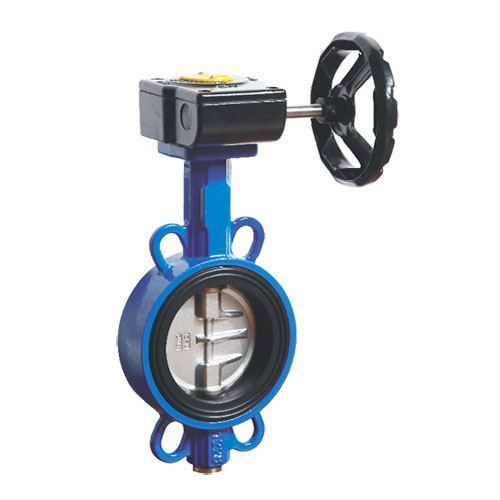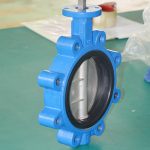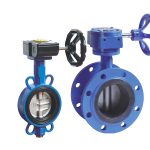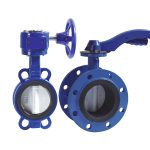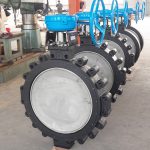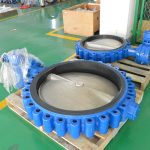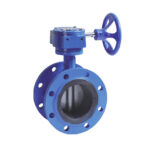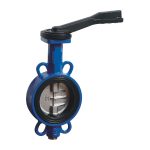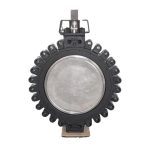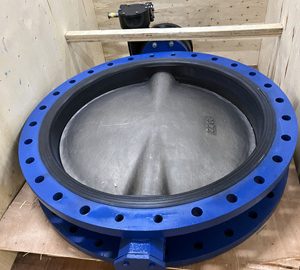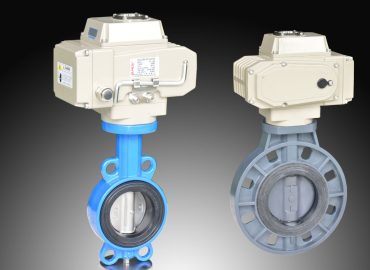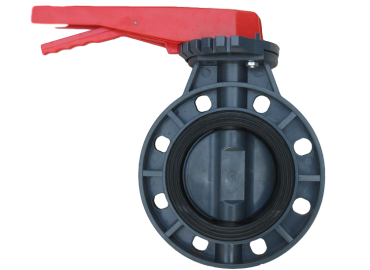Butterfly valves are a common type of control valve used in a wide range of industrial applications. These valves are designed to regulate fluid flow by using a disc-shaped element that rotates around a central axis to open or close the valve. However, the performance of butterfly valves can be significantly impacted by changes in temperature and pressure within the system. Understanding how temperature and pressure changes affect butterfly valve flange type performance is critical for ensuring optimal valve operation, safety, and overall system efficiency. In this blog post, we will explore the various factors that influence butterfly valve performance under different temperature and pressure conditions.
Introduction
The performance of wafer butterfly valve can be significantly influenced by temperature and pressure changes within the system. High temperatures can cause valve materials to weaken or degrade, resulting in reduced valve lifespan and potential for leakage. Low temperatures can also have an impact, as brittle fracture may occur if the valve material is not suitable for extreme cold conditions. Pressure changes can affect the torque required to operate the valve, as well as its sealing capability and resistance to leakage. Proper sizing and selection of valves for specific pressure ranges is crucial for optimal performance and safety. Understanding the interaction between temperature and pressure changes is also important for ensuring proper valve selection and application design. By taking these factors into consideration, operators can ensure reliable and efficient operation of butterfly valve flange types across a wide range of industrial applications.
Explanation of butterfly valves and their applications
Butterfly valves are mechanical devices used to regulate and control the flow of fluids in a piping system. They consist of a circular disc that rotates around a shaft, which controls the flow of fluid passing through the valve. Butterfly valves are commonly used in HVAC systems, water treatment plants, and chemical processing facilities due to their versatility and ease of use. They are particularly useful in applications that require precise control of flow rates, as they can be adjusted with great precision. The design of butterfly valves also makes them ideal for controlling the flow of corrosive or abrasive fluids, as they are less likely to corrode than other types of valves. Overall, butterfly valves are a popular choice for applications where efficient flow control is essential.
Importance of understanding how temperature and pressure changes affect their performance
Understanding how temperature and pressure changes affect the performance of a system is crucial in ensuring that the system operates efficiently and safely. For instance, changes in temperature and pressure can impact the viscosity and density of fluids, which can affect the flow rate and efficiency of pumps, compressors, and turbines. In addition, high temperatures and pressures can cause expansion and contraction of materials, which can lead to deformation or failure of the system components. Therefore, it is important to consider the impact of these changes when designing, operating, and maintaining a system. By doing so, engineers and operators can optimize the performance of the system while minimizing the risk of failure or damage due to temperature and pressure changes.
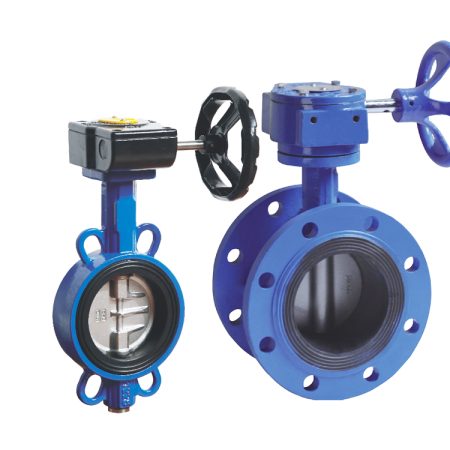
Temperature Changes
Temperature changes can have a significant impact on various aspects of our lives, from the weather and climate to the performance of machines and equipment. Temperature variations can affect the behavior of fluids, gases, and solids, leading to changes in their properties such as viscosity, density, and thermal conductivity. For example, at low temperatures, some materials may become brittle and prone to fracture, while at high temperatures, they may soften or melt. Temperature changes can also impact the efficiency and safety of industrial processes, such as chemical reactions and power generation. Therefore, it is essential to understand how temperature changes affect different systems and take appropriate measures to ensure optimal performance and safety. This can include using thermal insulation, temperature control systems, and monitoring equipment to track temperature variations and make necessary adjustments.
Effect of high temperatures on valve material and components
High temperatures can have a significant impact on the materials and components used in valves, potentially leading to deformation, corrosion, or failure. For example, prolonged exposure to high temperatures can cause some metals to lose their strength and become more susceptible to cracking or warping. High temperatures can also accelerate corrosion, particularly in materials that are not resistant to oxidation or chemical reactions. In addition, high temperatures can cause deterioration of seals and gaskets, leading to leaks or reduced performance. Therefore, it is essential to select valve materials that are suitable for the intended temperature range and to ensure proper maintenance and inspection to detect any signs of wear or damage. Regular testing and monitoring can help identify potential issues before they result in failures or safety hazards.
Impact of thermal expansion on sealing capability
Thermal expansion can have a significant impact on the sealing capability of materials. When materials are heated, they can expand, causing gaps to form in between them. If these gaps occur in a seal or joint, it can compromise the effectiveness of the sealing and allow leakage to occur. This is especially important in industries where tight seals are critical, such as in aerospace, automotive or chemical manufacturing. In order to maintain the integrity of seals and joints, it is important to understand the thermal expansion characteristics of the materials being used and to design seals with this in mind.
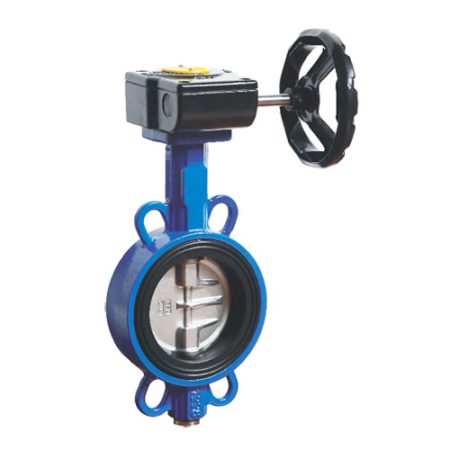
Importance of proper material selection for high-temperature applications
Proper material selection is crucial for high-temperature applications. Materials that are suitable for use at room temperature may not be able to withstand the harsh conditions of high temperatures, causing them to break down or fail over time. This can result in significant safety risks, equipment damage or even loss of life. In order to ensure the safe and effective operation of high-temperature applications, materials must be carefully selected based on their ability to withstand the specific temperature ranges, as well as other factors such as chemical compatibility, mechanical strength, and thermal expansion. The importance of proper material selection cannot be overstated when working with high-temperature applications, and it is critical to consult with experts in the field to ensure the best possible outcomes.
Considerations for low-temperature applications and potential for brittle fracture
When designing for low-temperature applications, it is important to consider the potential for brittle fracture in materials. Brittle fracture occurs when a material breaks suddenly and without warning under stress, typically at low temperatures. This can be a serious safety concern in applications such as cryogenic storage tanks, pipelines, and pressure vessels. To prevent brittle fracture, it is important to select materials with high toughness and ductility, as well as to avoid stress concentrations and ensure proper fabrication and welding procedures. Additionally, it is crucial to carefully monitor temperature changes and avoid sudden temperature fluctuations that can cause thermal shock and promote brittle fracture. By taking these considerations into account, designers can ensure the safe and reliable performance of low-temperature applications.
Pressure Changes
Pressure changes can have a significant impact on the behavior of gases and fluids. When pressure is increased, the volume of a gas or fluid will decrease, while decreased pressure will cause volume to increase. This relationship is described by Boyle’s Law, which states that the pressure of a gas is inversely proportional to its volume at a constant temperature. In addition to affecting volume, changes in pressure can also alter the boiling point of liquids and the vapor pressure of gases, which can impact their overall behavior and stability. In industrial settings, pressure changes are often used to control the flow and behavior of gases and fluids, and must be carefully monitored to ensure safety and proper operation.
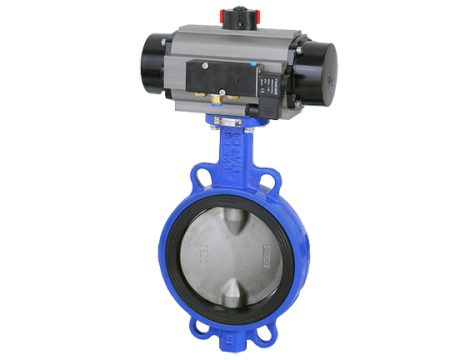
Relationship between pressure and torque required to operate the valve
The relationship between pressure and torque required to operate a valve can vary depending on the design and characteristics of the valve. In general, valves that require higher levels of pressure to operate will also require higher levels of torque. This is because the force required to overcome the resistance of the valve mechanism is proportional to the pressure acting on the valve. Additionally, valves with larger diameters or those that are designed for heavy-duty applications may require more torque to operate due to their increased size and weight. Proper selection of a valve based on the specific application requirements is crucial to ensure that the correct level of pressure and torque is applied for safe and efficient operation. Regular maintenance and calibration of valve actuators can also help to ensure accurate and reliable performance over time.
Effect of excessive pressure on sealing capability and possible leakage
Excessive pressure can have a detrimental effect on the sealing capability of gaskets and other sealing materials, leading to possible leakage in a system. When a sealing material is subjected to high levels of pressure, it may become deformed or crushed, compromising its ability to create a tight seal between two surfaces. This can result in leaks or loss of fluid or gas from the system, which can be costly and potentially dangerous. In addition to causing physical damage to the sealing material, excessive pressure can also cause it to degrade over time, leading to further deterioration of the sealing capability. Proper selection of sealing materials that are designed to withstand the specific pressure and temperature conditions of a system is critical to ensuring reliable and effective sealing performance. Regular inspection and maintenance of seals and gaskets can also help to detect and prevent potential leaks before they occur.
Importance of properly sizing and selecting valves for specific pressure ranges
Proper sizing and selection of valves is critical to ensuring safe and efficient operation in a wide range of industrial applications. It is particularly important to select valves that are designed to operate within the specific pressure range of the system in which they will be used. Valves that are improperly sized or selected can cause significant problems, including increased wear and tear on the valve mechanism, decreased efficiency, and potential safety hazards. When selecting valves, it is important to consider factors such as the flow rate, fluid type and temperature, and the required level of precision and control. Properly sizing and selecting valves based on these factors can help to ensure optimal performance and longevity, while minimizing the risk of system failure or other issues. Regular maintenance and inspection of valves can also help to detect and prevent potential problems before they occur, further improving reliability and safety.
Considerations for high-pressure applications and potential for valve body deformation
High-pressure applications require careful consideration when selecting and installing valves to prevent valve body deformation. Valve body deformation can occur due to the high pressures exerted on the valve, causing it to distort or become misshapen. This can result in leaks or other issues that compromise the safety and efficiency of the system. One way to prevent valve body deformation is to select valves that are designed specifically for high-pressure applications and that are made from materials that can withstand the forces involved. Additionally, proper installation and mounting techniques, such as using proper gaskets and torque values, can help to distribute pressure evenly across the valve body and prevent deformation. Regular inspection and maintenance of valves can also help to detect and prevent potential problems before they occur. By taking these considerations into account, designers can ensure reliable and safe performance of high-pressure systems.
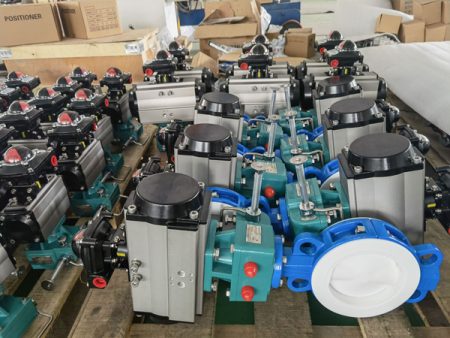
Combined Temperature and Pressure Changes
Combined temperature and pressure changes can have a significant impact on the behavior of gases and fluids in industrial applications. When both temperature and pressure are changed simultaneously, the volume, density, viscosity, and other physical properties of gases and fluids will be impacted in complex ways. For example, when temperature is increased, the pressure required to maintain a constant volume also increases, while decreasing temperature will decrease pressure requirements. Careful consideration of these interrelated variables is essential when designing and operating industrial systems, as failure to properly account for them can result in system instability, equipment damage, and other safety hazards. To ensure reliable and safe operation, it is important to use appropriate materials and components that are designed to withstand the combined effects of temperature and pressure changes, and to carefully monitor and control system conditions. Regular maintenance and calibration of instruments and equipment can further help to ensure accurate and reliable performance over time.
Interaction of temperature and pressure changes on valve performance
The interaction of temperature and pressure changes can have a significant impact on valve performance in industrial applications. When exposed to temperature and pressure changes, valves may experience changes in viscosity, flow rate, and other properties that can affect their performance. For example, high temperatures can cause valve components to expand, increasing the force required to operate them, while low temperatures can cause components to contract, making them more susceptible to damage. Similarly, changes in pressure can cause valve components to flex or deform, affecting their ability to create a tight seal and potentially causing leaks or other issues. To ensure optimal valve performance under varying temperature and pressure conditions, it is important to select valves that are designed for the specific application and that are made from materials that can withstand the forces involved. Regular inspection and maintenance of valves can also help to detect and prevent potential problems before they occur, further improving reliability and safety.
Importance of considering both factors in valve selection and application design
Considering both temperature and pressure factors is critical when selecting valves and designing applications in industrial settings. Failure to take these factors into account can result in inefficient or unsafe operation, equipment damage, and other issues. When selecting valves, it is important to evaluate the specific pressures and temperatures that will be encountered in the application, as well as any potential fluctuations or changes over time. The chosen valve must be able to withstand the forces involved and operate effectively across the range of expected conditions. Similarly, when designing a system or application, it is important to ensure that all components, including valves, are properly rated for the expected temperature and pressure ranges. By taking a holistic approach to valve selection and application design, engineers can ensure reliable and safe operation under challenging and variable conditions. Regular maintenance and inspection of valves can also help to detect and prevent potential problems before they occur, further improving reliability and safety.
Examples of common industry applications with varying temperature and pressure requirements
There are numerous industry applications that require different temperature and pressure requirements, and selecting the correct valves is essential to meet the specific needs of each application. For example, in chemical processing, valves are often used to regulate the flow of fluids that are subjected to high temperatures and pressures. In food and beverage processing, valves are used to control the flow of liquids such as dairy, beer, and wine, which require precise temperature and pressure regulation. In oil and gas production, valves must be able to withstand high temperatures and pressures while also preventing leaks and ensuring reliable operation over long periods of time. Other common applications that require careful consideration of temperature and pressure factors include water treatment, power generation, pharmaceutical manufacturing, and semiconductor fabrication. By selecting valves that are designed specifically for the unique temperature and pressure requirements of each application, engineers can ensure optimal performance, reliability, and safety in a wide range of industrial settings.
Conclusion
In conclusion, the performance of lug butterfly valve flange type can be significantly affected by changes in temperature and pressure. These factors can impact the physical properties of the valve and its ability to create a tight seal, which is essential for safe and efficient operation in industrial applications. When selecting butterfly valves, it is important to consider the specific temperature and pressure requirements of the application in which they will be used, as well as any potential fluctuations or changes over time.
Choosing the right materials and components is also crucial for ensuring reliable and safe valve operation under varying temperature and pressure conditions. Valves made from materials such as high-strength alloys, polymers, and ceramics are better suited for use in high-temperature and high-pressure applications. Additionally, proper installation and maintenance techniques, such as using appropriate gaskets and torque values, can help to prevent deformation and other issues that can compromise valve performance.
Regular inspection and maintenance of valves can also help to detect and prevent potential problems before they occur. By monitoring valve performance over time, engineers can identify changes or trends that may indicate a potential issue and take corrective action before it leads to equipment damage or other safety hazards.
Ultimately, considering both temperature and pressure factors is critical when selecting butterfly valves and designing applications in industrial settings. By taking a holistic approach to valve selection and application design, engineers can ensure reliable and safe operation under challenging and variable conditions. This can help to minimize downtime, increase efficiency, and improve overall productivity, while also protecting workers and the environment from potential hazards.
Recap of key takeaways for understanding butterfly valve flange type performance in relation to temperature and pressure changes
Understanding butterfly valve flange type performance in relation to temperature and pressure changes is crucial for ensuring optimal performance and avoiding operational issues. After reviewing the information presented, some key takeaways include the importance of selecting the right material for the flange type, understanding the effects of temperature and pressure changes on the valve’s performance, and regularly monitoring and maintaining the valve to prevent damage or failure. It is also important to choose a flange type that is compatible with the specific application and operating conditions, and to consider factors such as flow rate, viscosity, and the presence of solids or corrosive materials. By following these guidelines, users can ensure the safe and efficient operation of their butterfly valve flange type in a variety of industrial settings.
Emphasis on the importance of proper valve selection and application design for optimal performance and safety
Proper valve selection and application design are critical for achieving optimal performance and ensuring safe operation in industrial settings. When selecting a valve, engineers must consider factors such as flow rate, pressure, temperature, and the properties of the fluid being transported. A pneumatic valve that is not properly matched to the application can result in reduced efficiency, increased energy consumption, and potential safety hazards. Additionally, application design plays a crucial role in ensuring the safe and efficient operation of valves. Engineers must consider factors such as system layout, piping configuration, and the placement of valves to minimize pressure drop and ensure proper flow control. Regular maintenance and inspection also play a vital role in ensuring the long-term performance and reliability of valves. By emphasizing the importance of proper valve selection and application design, engineers can help improve safety, efficiency, and overall performance in industrial settings.


